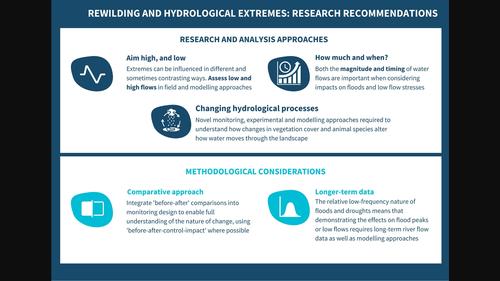The role of rewilding in mitigating hydrological extremes: State of the evidence
引用次数: 0
Abstract
Landscape rewilding has the potential to help mitigate hydrological extremes by allowing natural processes to function. Our systematic review assessed the evidence base for rewilding-driven mitigation of high and low flows. The review uncovers a lack of research directly addressing rewilding, but highlights research in analogue contexts which can, with caution, indicate the nature of change. There is a lack of before-after studies that enable deeper examination of temporal trajectories and legacy effects, and a lack of research on the scrub and shrubland habitats common in rewilding projects. Over twice as much evidence is available for high flows compared to low flows, and fewer than one third of studies address high and low flows simultaneously, limiting our understanding of co-benefits and contrasting effects. Flow magnitude variables are better represented within the literature than flow timing variables, and there is greater emphasis on modeling for high flows, and on direct measurement for low flows. Most high flow studies report a mitigating effect, but with variability in the magnitude of effect, and some exceptions. The nature of change for low flows is more complex and suggests a higher potential for increased low flow risks associated with certain trajectories but is based on a very narrow evidence base. We recommend that future research aims to: capture effects on both high and low flow extremes for a given type of change; analyze both magnitude and timing characteristics of flow extremes; and examine temporal trajectories (before and after data) ideally using a full before-after-control-impact design.

野化在缓解极端水文现象中的作用:证据现状
通过让自然过程发挥作用,景观野化有可能帮助缓解极端水文现象。我们的系统性综述评估了以野化为驱动力缓解高流量和低流量的证据基础。综述发现,缺乏直接针对野化的研究,但强调了模拟背景下的研究,这些研究可以谨慎地说明变化的性质。此外,也缺乏对野化项目中常见的灌木丛和灌木地栖息地的研究。与低流量相比,高流量方面的证据要多一倍以上,但只有不到三分之一的研究同时涉及高流量和低流量,这限制了我们对共同效益和对比效应的理解。与流量时间变量相比,流量大小变量在文献中得到了更好的体现,而且大流量研究更注重建模,小流量研究更注重直接测量。大多数大流量研究都报告了缓解效果,但效果的大小不一,也有一些例外。低流量变化的性质更为复杂,表明与某些轨迹相关的低流量风险增加的可能性更大,但所依据的证据基础非常狭窄。我们建议,未来的研究应着眼于:捕捉特定类型变化对高流量和低流量极端值的影响;分析极端流量的大小和时间特征;以及研究时间轨迹(前后数据),最好采用全面的前后控制-影响设计。
本文章由计算机程序翻译,如有差异,请以英文原文为准。
求助全文
约1分钟内获得全文
求助全文

 求助内容:
求助内容: 应助结果提醒方式:
应助结果提醒方式:


